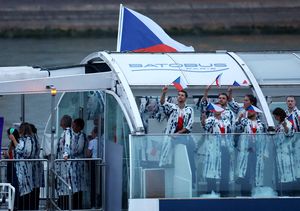The Olympics in Paris is probably just what the doctor ordered for the fashion business. Taking the world’s greatest sports festival to the world’s best-loved fashion capital can only mean good things for a bleeding fashion industry. All eyes are on the style check of participants, whether it is the opening ceremony costumes or how the independent athletes are togged up.
Much ink has been spilled on the Indian team’s ceremonial outfits. Designed by menswear label Tasva of the Aditya Birla Fashion and Retail group, of which Tarun Tahiliani is the creative head and partner, the dress code was met with universal disappointment. While on the one hand people felt more heritage needed to be paid heed to, on the other, they felt the outfits were unimaginative. Oddly, no one had commented on the Tokyo Olympics where the contingent was outfitted by Raymond, but with a big-ticket designer like Tahiliani involved, more was naturally expected.
This is the first time there seems to be a fashion intervention in the designs of the Olympic uniforms. Which by itself is a big deal, as several countries already have famous designers making gorgeous clothes for them, like Ralph Lauren in the US and Berluti and Dior in France.
Tahiliani is an extraordinary designer where his masterly embroideries or historical references, like Mughal history, are concerned. His clothes are known to have “engineered” fits, for even plus-size women. He uses revolutionary fabrics and techniques, and is gifted at making Indian clothes appear slinkier and sexier than evening gowns and cocktail dresses. Tasva, on its part, is also an incredibly chic and affordable men’s ethnic wear label—it can be even cheaper than Fabindia.
I hope there is a better understanding of how and why the design went so wrong for our contingent, but the current official response by the designer is insufficient. Olympic uniforms are meant to have cultural signifiers, flag details as well as an element of sportswear. They are meant to be stylish and eye-catching. Ours was neither.
Everyone agrees Mongolia had great cultural references in its outfits designed by sisters Michel, Amazonka and Munkhjargal Choigaalaa of the couture label ‘Michel & Amazonka’. They took three months to design and execute the uniforms which are filled with gold and silver embroideries of birds and mountains.
Another personal favourite was the Haiti uniforms by Haitian-Italian fashion designer Stella Jean, who used the art of local artist Philippe Dodard in the full skirts of the female athletes. The men’s jackets were inspired by the classic Haitian shirt, the Guayabera.
The Netherlands team had an all-orange kit which looked like chic carpenters’ uniforms. The Czech Republic was another gem; they had a collaboration between Alpine Pro and designer Jan Cerny. Their inky patterns were a nod to local artist Vladimir Boudnik.
The Paris Olympics are also delightful as they are said to be the most gender-equal sports festival ever. For the first time in history, they have an equal number of women and men athletes taking part. They have allowed for daycare and breastfeeding facilities for female athletes who have young children (Tokyo games had banned these). But Paris has also banned the hijab, keeping in mind France’s laicite rules.
Refreshingly, a TV commentator’s sexist remark during a swimming competition called for his removal. He had said about Australian swimmers, “You know what women are like…. Hanging around, doing their makeup”.
In another time or another country, this may have been considered good humour and harmless banter. But in most parts of the world, the ladies are determined to tell the men to stay in their lane.
X@namratazakaria


